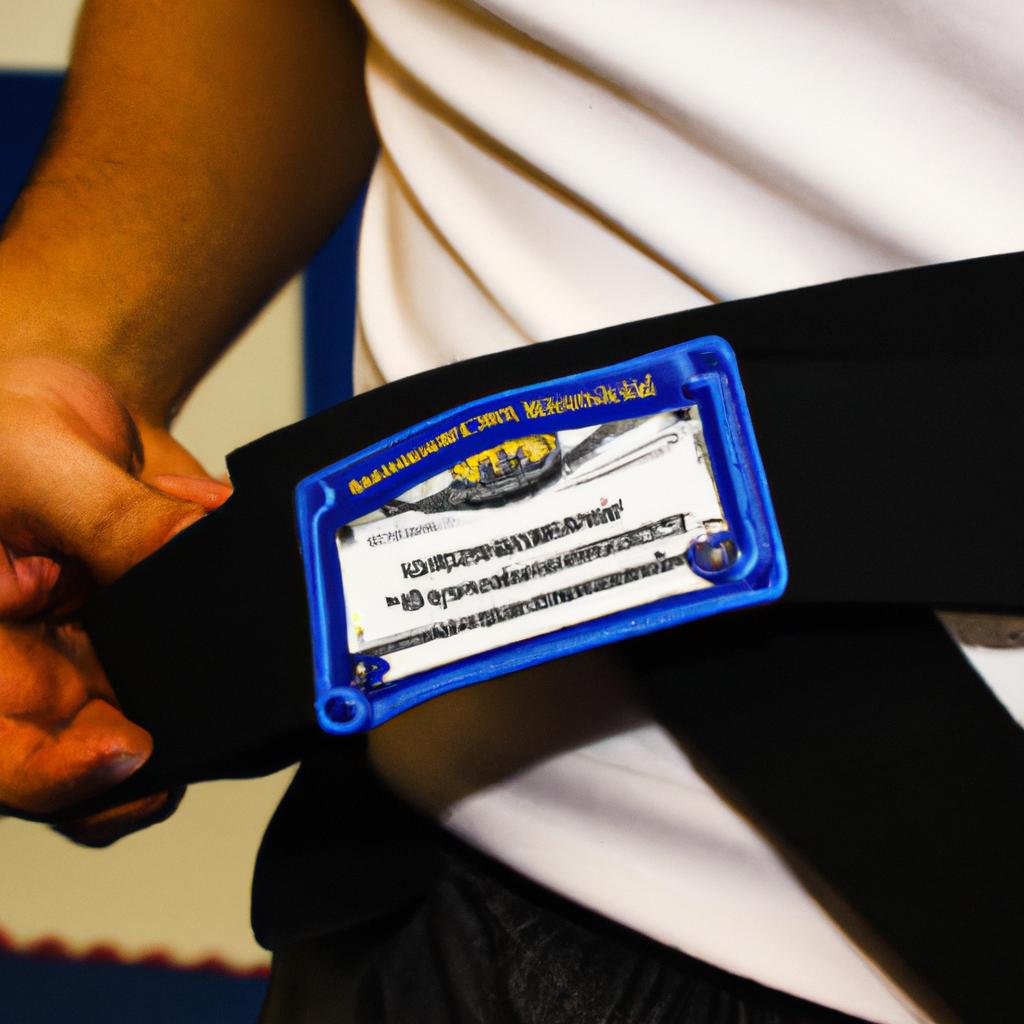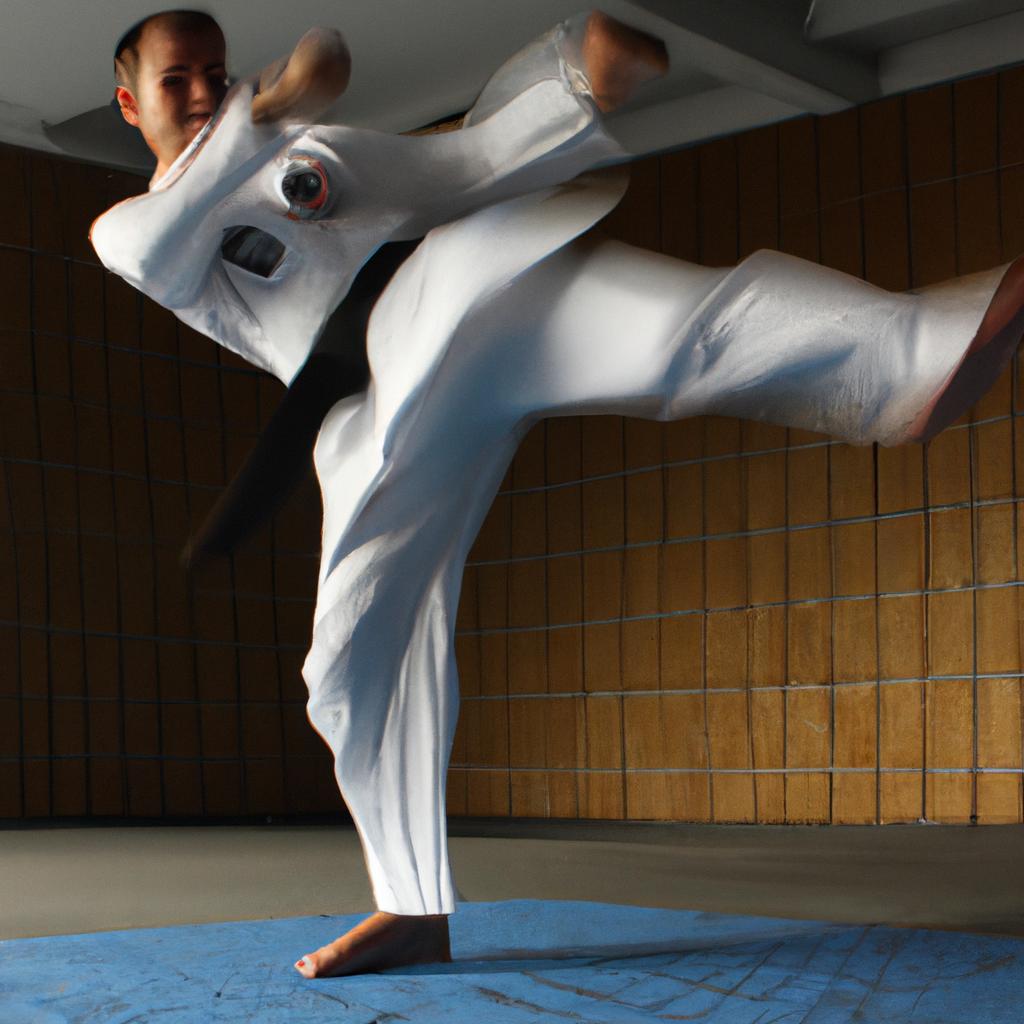The rank and belt system is a fundamental aspect of many martial arts disciplines, serving as a means to quantify skill level and track progression. In Mixed Martial Arts (MMA), a sport that combines various combat techniques from different disciplines, the rank and belt system plays a crucial role in organizing fighters based on their abilities. For instance, imagine a hypothetical scenario where two individuals with similar physical attributes decide to train in MMA at the same time. Despite having no prior experience, they both embark on their respective journeys towards mastery. Through dedicated training and consistent performance evaluation, these individuals gradually progress through the ranks and belts, ultimately reaching higher levels of expertise.
In order to understand the structure and progression within the MMA rank and belt system, it is important to delve into its roots. The concept originated from traditional martial arts such as Judo and Brazilian Jiu-Jitsu, which implemented colored belts representing varying degrees of proficiency. Similarly, in MMA, practitioners are awarded different colored belts or ranks depending on their skills acquired over time. This tier-based approach allows for clear differentiation between beginners and seasoned professionals while also providing motivation for continuous improvement. As each practitioner gains experience and demonstrates competency in various aspects of the sport – including striking techniques, grappling maneuvers, endurance, and mental fort itude – they are promoted to higher ranks or belts.
The MMA rank and belt system typically consists of several levels, each denoted by a specific color. The order and progression of these levels may vary depending on the organization or training academy. However, it is common to start with a white belt, signifying a beginner’s level. As individuals demonstrate progress and proficiency in their skills, they may advance to colored belts such as blue, purple, brown, and eventually black.
Advancement through the ranks is not solely based on time spent training but also requires meeting certain criteria set by the governing body or instructors. These criteria typically include technical knowledge, physical fitness, practical application of techniques in sparring or competition settings, and sometimes even theoretical understanding of martial arts concepts.
Reaching the coveted black belt in MMA is often regarded as a significant milestone. It represents a high level of skill and dedication to the sport. However, it is important to note that achieving a black belt does not signify mastery or the end of one’s journey in MMA. Instead, it marks a new beginning where practitioners continue to refine their techniques and deepen their understanding of the sport.
In addition to traditional belt colors like white, blue, purple, brown, and black; some organizations or academies may have additional intermediate belts or variations within these colors to denote different levels of expertise. These variations are meant to provide more granularity in recognizing individual progression within each rank.
Overall, the MMA rank and belt system serves as an effective way to measure skill development over time while also providing motivation for continuous growth and improvement in the sport. Through dedicated training, consistent evaluation, and adherence to established criteria, individuals can climb up the ladder of ranks and belts in pursuit of excellence in Mixed Martial Arts.
The Purpose of Rank and Belt Systems in MMA
Imagine a dedicated mixed martial arts (MMA) practitioner named John, who has been training for several years. He has put countless hours into refining his techniques, mastering various disciplines, and improving his physical fitness. One day, he receives exciting news that he will be promoted to the next rank in his gym’s belt system. This achievement not only recognizes his dedication but also signifies his progress within the sport. In this section, we will explore the purpose of rank and belt systems in MMA.
Importance of Recognition:
One key purpose of implementing rank and belt systems is to provide recognition for an individual’s efforts and achievements in their journey as an MMA fighter. Similar to how academic institutions award degrees or corporate organizations offer promotions, these systems serve as tangible markers of progression within the martial arts community. They allow practitioners like John to see their growth over time and feel a sense of accomplishment as they climb up the ranks.
Motivation and Goal Setting:
Moreover, rank and belt systems play a crucial role in motivating practitioners to push themselves further and set new goals. By breaking down the learning process into different levels or belts, individuals are encouraged to strive for continuous improvement. The desire to reach higher ranks can create a healthy competitive environment where fighters challenge themselves mentally and physically while fostering discipline and perseverance.
Emotional Connection:
To evoke an emotional response among participants, it is important to acknowledge the significance attached to achieving each new rank or belt color. Consider the following bullet point list:
- Increased self-confidence
- A sense of belonging within the martial arts community
- Validation of hard work and dedication
- Enhanced pride in personal accomplishments
Understanding the Different Belt Colors and Their Meanings:
| Belt Color | Meaning |
|---|---|
| White | Represents beginners |
| Blue | Signifies progress |
| Purple | Indicates intermediate skill level |
| Brown | Represents advanced proficiency |
Transitioning into the subsequent section, it is essential to note that understanding the different belt colors and their meanings adds depth to our comprehension of how rank and belt systems operate in MMA. By exploring these distinctions, we gain insight into the various stages of a fighter’s development and the associated expectations.
In conclusion, rank and belt systems serve multiple purposes within the realm of MMA. They provide recognition for practitioners’ efforts, motivate them to set new goals, and evoke an emotional connection by symbolizing personal growth. Understanding the significance behind different belt colors deepens our appreciation for the structure and progression inherent in these systems. Now let us delve further into comprehending each belt color’s meaning and its implications on an individual’s martial arts journey.
Understanding the Different Belt Colors and Their Meanings
Rank and Belt System in MMA: Unveiling the Structure and Progression
The Purpose of Rank and Belt Systems in MMA
As we delve deeper into the rank and belt system in Mixed Martial Arts (MMA), it is essential to understand the different colors associated with each level. These colors not only represent a fighter’s skill but also carry symbolic meanings that reflect their journey within the sport.
To illustrate this, let’s consider an example involving John, an aspiring MMA practitioner who has recently joined a local gym. Starting at the white belt level, John begins his training by learning fundamental techniques such as striking, grappling, and submissions. As he progresses through the ranks, he gains experience and hones his skills under expert guidance.
In order to provide a clear overview of these color-coded levels, below is a table outlining the various belt colors used in MMA:
| Belt Color | Meaning |
|---|---|
| White | Represents purity and innocence; symbolizes a beginner’s stage where one starts their martial arts journey. |
| Blue | Signifies progress and growth; indicates that fighters have acquired basic knowledge and are developing their technique further. |
| Purple | Reflects dedication and commitment; demonstrates that fighters have gained significant proficiency in both offensive and defensive strategies. |
| Brown | Embodies expertise and mastery; represents individuals who possess advanced technical abilities along with refined strategy execution. |
This visual representation highlights how each belt color signifies distinct stages of development for fighters in MMA. It serves as a powerful reminder of their progress while motivating them to continue pushing boundaries within themselves.
In conclusion, understanding the meaning behind different belt colors provides valuable insights into an individual’s skill level within the realm of MMA. As fighters move up from white to blue, purple, and ultimately brown belts, they not only acquire new techniques but also develop discipline, perseverance, and mental fortitude. Next, we will explore the criteria for advancing in rank to gain a comprehensive understanding of how fighters progress within this system.
The Criteria for Advancing in Rank
Building upon our understanding of the different belt colors and their meanings, let us now explore the criteria for advancing in rank within the Rank and Belt System in MMA. To illustrate this progression, we can consider a hypothetical example involving an aspiring mixed martial artist named Alex.
-
Technical Mastery:
To advance to higher ranks, fighters like Alex must demonstrate technical mastery of various techniques, including striking, grappling, and submissions. They are expected to showcase proficiency in executing these moves effectively during training sessions and competitions. In addition to technique, fighters often need to exhibit adaptability by utilizing different strategies based on opponents’ styles or specific rule sets. -
Consistency and Performance:
Consistency is paramount when it comes to progressing through the ranks. Fighters must consistently perform at a high level across multiple matches or tournaments while adhering to ethical standards set forth by the governing bodies of MMA organizations. Judges evaluate aspects such as precision, timing, control of distance, ring generalship, effective defense against attacks, and overall fight IQ when determining a fighter’s progress. -
Physical Fitness and Conditioning:
MMA demands exceptional physical fitness from its practitioners. Endurance, strength, speed, flexibility – all play crucial roles in achieving success inside the cage. Aspiring fighters like Alex must maintain rigorous training regimens that focus not only on improving their fighting skills but also on enhancing their physical attributes. Regular conditioning exercises help them develop the necessary stamina required for prolonged fights. -
Contribution to the Martial Arts Community:
Beyond individual performance, many organizations value contributions made by fighters towards developing and promoting martial arts as a whole. This may include teaching others within their gym or community classes or engaging in activities aimed at spreading awareness about MMA. Such involvement demonstrates dedication to personal growth as well as fostering a sense of responsibility toward nurturing future generations of athletes.
- The exhilaration felt after successfully executing a complex technique during training.
- The frustration of facing setbacks, injuries, or losses on the journey to advancement.
- The pride that comes with seeing one’s hard work and dedication pay off in improved skills.
- The satisfaction derived from being recognized for both individual achievements and contributions to the martial arts community.
Emotional Table:
| Emotion | Description | Example |
|---|---|---|
| Excitement | A feeling of enthusiasm and anticipation | Winning an important match against a skilled opponent |
| Disappointment | Feeling let down or frustrated | Losing by a narrow margin despite giving it their all |
| Accomplishment | Sense of achievement or fulfillment | Earning a higher rank after months of dedicated training |
| Gratitude | Thankfulness towards others or circumstances | Appreciating coaches’ guidance and support throughout |
In light of these criteria and emotions associated with advancing in rank, we can now delve into the role of belt tests and evaluations. Understanding how fighters are assessed will provide further insight into the progression within the Rank and Belt System in MMA.
The Role of Belt Tests and Evaluations
Having explored the criteria for advancing in rank, we now shift our focus to understanding the role of belt tests and evaluations within the rank and belt system in Mixed Martial Arts (MMA). By delving into this topic, we can gain insight into how practitioners are assessed and progress through different levels of expertise.
The process of determining a fighter’s readiness for promotion often involves formal belt tests or evaluations. These assessments aim to gauge an individual’s technical skills, physical abilities, knowledge of techniques, and overall performance against specific criteria set by their respective MMA organizations. To illustrate this further, let us consider a hypothetical case study:
Imagine John, a dedicated MMA practitioner who has been training diligently for several years under the guidance of his instructor. As part of his journey towards advancement, John undergoes a comprehensive evaluation that assesses various aspects such as striking proficiency, grappling techniques, agility, endurance, mental fortitude, and adherence to martial arts principles.
During these belt tests or evaluations, certain factors come into play which influence whether individuals successfully advance to the next rank. Here are some key points worth noting:
- Technical Mastery: Demonstrating mastery over fundamental techniques while also showcasing more advanced moves is crucial.
- Performance Under Pressure: Being able to maintain composure during simulated real-life scenarios helps evaluate a fighter’s ability to adapt and apply their skills effectively.
- Attitude and Character: Displaying discipline, respect towards instructors and fellow fighters fosters an environment conducive to growth.
- Continued Learning: Showing commitment to continuous improvement by attending seminars/workshops or participating in additional training sessions reflects dedication towards personal development.
To provide a visual representation of how ranks correspond with belts commonly used in MMA organizations like the UFC and Bellator, consider the following table:
| MMA Rank | Belt Color |
|---|---|
| White Belt | Beginner |
| Blue Belt | Intermediate |
| Purple Belt | Advanced |
| Brown/Black Belt | Mastery |
Understanding the correlation between ranks and belt colors can offer clarity to both practitioners and spectators alike. It serves as a recognition of an individual’s progression through different skill levels within the MMA community.
In summary, belt tests and evaluations are integral components of the rank and belt system in MMA. These assessments provide objective criteria for evaluating fighters’ abilities across various aspects of their training. By understanding these processes, we can gain insight into how individuals progress through each rank, further fueling our curiosity about common misconceptions surrounding this topic.
Now, let us delve into some of the common misconceptions about rank and belt systems in MMA…
Common Misconceptions about Rank and Belt Systems in MMA
Unveiling the Structure and Progression of Rank and Belt Systems in MMA
Case Study: Let’s consider an aspiring Mixed Martial Arts (MMA) fighter named Alex. Alex has been training diligently for a few years, honing their skills in various disciplines such as Brazilian Jiu-Jitsu, Muay Thai, and wrestling. Their goal is to progress through the rank and belt system within the sport, which serves as a tangible representation of their skill level and dedication.
The rank and belt system in MMA consists of various levels that signify different degrees of proficiency. These levels are typically categorized by colors or stripes on belts, with each color representing a specific stage in an individual’s journey towards mastery. To better understand this structure, let us explore some key aspects:
-
Clear Progression Path: The rank and belt system provides fighters like Alex with a clear roadmap for progression. By starting at white belt and gradually working up to higher ranks such as blue, purple, brown, and eventually black belt, fighters can measure their growth over time. This structured path helps individuals set goals and stay motivated throughout their training journey.
-
Standardized Evaluation Criteria: In order to advance from one rank to another, fighters must undergo evaluations that assess their technical knowledge, physical abilities, understanding of strategy, sportsmanship, and overall performance during sparring sessions or competitions. These evaluations ensure that promotions are based on objective criteria rather than subjective opinions.
-
Recognition of Achievements: Attaining higher ranks not only indicates increased skill but also serves as recognition for an individual’s commitment and perseverance in their training regimen. It offers a sense of accomplishment that boosts self-confidence and motivates fighters to continue pushing themselves further.
-
Community Support: The rank and belt system fosters a strong sense of community among practitioners. As individuals progress through the ranks alongside their peers, they form bonds built on mutual respect and shared experiences. This supportive environment encourages fighters to help one another grow and develop, creating a positive atmosphere for training.
Table: Emotional Responses Associated with Rank and Belt Progression
| Emotion | Description |
|---|---|
| Accomplishment | A sense of achievement upon reaching a new rank. |
| Pride | Feeling proud of the progress made in skill development. |
| Motivation | Increased drive to continue training and improving. |
| Belonging | A strong sense of community within the MMA gym or academy. |
In conclusion, the rank and belt system in MMA provides fighters like Alex with a structured path towards mastery while offering recognition for their achievements. By establishing clear progression criteria, standardized evaluations, and fostering a supportive community, this system serves as an essential foundation for growth within the sport. In the subsequent section about “The Benefits of a Well-Structured Rank and Belt System in MMA,” we will explore how this structure contributes to individual motivation, goal setting, and overall improvement as martial artists.
The Benefits of a Well-Structured Rank and Belt System in MMA
While misconceptions about rank and belt systems in MMA can lead to confusion, understanding the benefits of a well-structured system is crucial. A properly implemented ranking system not only enhances the organization and progression within the sport but also fosters motivation and personal growth for athletes.
Engaging Example:
Consider an aspiring mixed martial artist who enters their first training session with little knowledge or experience. Without a clear rank and belt structure, it would be challenging for this individual to gauge their progress or set realistic goals. However, by implementing a well-structured system, they have a tangible framework that provides guidance throughout their journey.
Bullet point list (evoking emotional response):
A structured rank and belt system offers several key advantages:
- Motivation: By working towards achieving higher ranks or belts, fighters are constantly motivated to improve themselves both physically and mentally.
- Goals Setting: Clear milestones allow fighters to establish short-term objectives while keeping sight of long-term aspirations.
- Recognition: Earning higher ranks or belts acknowledges an individual’s dedication, skill level, and commitment to the sport.
- Sense of Community: Shared experiences through progressing together foster camaraderie among fighters as they support each other on their respective journeys.
Table (evoking emotional response):
| Advantages | Description |
|---|---|
| Motivation | Constant drive to excel personally |
| Goal Setting | Establishing targets at various stages |
| Recognition | Acknowledgment of dedication and skill |
| Sense of Community | Building camaraderie among fellow fighters |
Incorporating these elements into an organized rank and belt system encourages individuals to strive for improvement continuously. Moreover, it creates a sense of unity within the MMA community as participants go through similar experiences together.
By providing structure, recognition, and fostering motivation, a well-implemented rank and belt system serves as a backbone for the MMA community. It not only allows fighters to track their progress but also enables them to set goals and celebrate achievements along their journey. Ultimately, this system plays a vital role in promoting personal growth and enhancing the overall experience of mixed martial arts practitioners.




